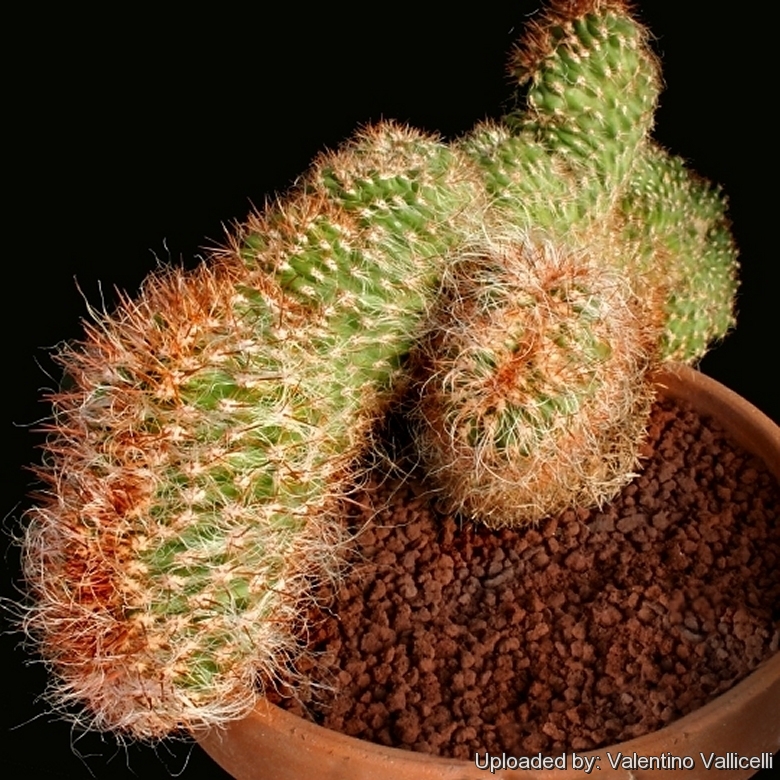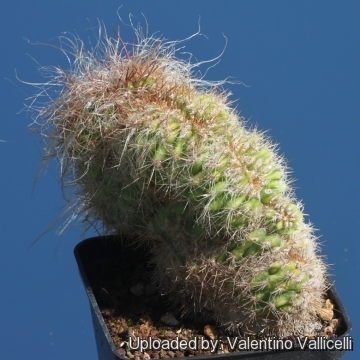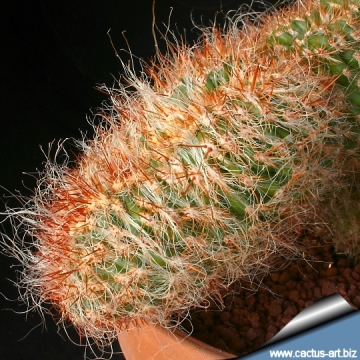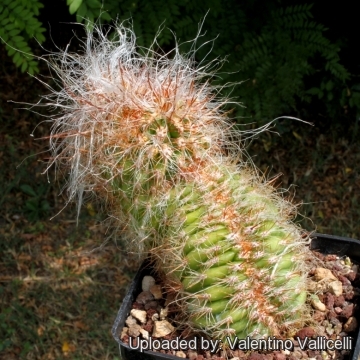Accepted Scientific Name: Oreocereus trollii Kupper
Monatsschr. Deutsch. Kakteen-Ges. 1: 96, in obs. 1929

Oreocereus trollii f. cristata Photo by: Valentino Vallicelli
This is a wonderfull crest of the “Old Man Cactus” of the Andes. This plant have nice fox-red sharp spines hidden within abundant white hairs.
Origin and Habitat: Garden origin.
Synonyms:
See all synonyms of Oreocereus trollii
back
Accepted name in llifle Database:Oreocereus trollii KupperMonatsschr. Deutsch. Kakteen-Ges. 1: 96, in obs. 1929Synonymy: 10
back
Description: The typical Oreocereus trolliiSN|3392]]SN|3392]] (a.k.a. the Old Man of the Andes) is a s shrubby columnar cactus with fine, completely enveloping hair and powerful coloured spination.
The beautiful crested form is very rare in collection and highly priced for its sculptural shape and cocoon-like covering of wool (actually radial spines that have evolved to resemble "hairs"). The crested form can get big making a spectacular specimen. Older crested plant can reach a considerable size (up to 40 cm tall and in diameter).
Stems: Fan-shaped 6-10 cm thick, light-green with a dense, wool which covers the stem and from which spines emerge.
Ribs: Low, strongly tuberculate.
Radial spines: Oreocereus trolliiSN|3392]]SN|3392]] has 10 to 15 very fine creamy-white or greyish modified spines up to 7 cm long that look like hair or wool.
Central spines: 3-5, stout awl-like up to 5 cm yellow, orange, orange-red or brown, dark tipped, protruding through the fine, woolly, hair-like radial spines.
Flowers: Up to 4 cm long pink to violet red and semi-tubular in shape.
Blooming season: Summer.
Fruits: Globose.
More...Subspecies, varieties, forms and cultivars of plants belonging to the Oreocereus trollii group
Bibliography: Major references and further lectures
1) Edward Anderson “The Cactus family” Timber Press, Incorporated, 2001
2) James Cullen, Sabina G. Knees, H. Suzanne Cubey "The European Garden Flora Flowering Plants: A Manual for the Identification of Plants Cultivated in Europe, Both Out-of-Doors and Under Glass" Cambridge University Press, 11/Aug/2011
3) David R Hunt; Nigel P Taylor; Graham Charles; International Cactaceae Systematics Group. "The New Cactus Lexicon" dh books, 2006
4) Urs Eggli, Leonard E. Newton: “Etymological Dictionary of Succulent Plant Names” Springer, Berlin/Heidelberg 2010
5) N. L. Britton, J. N. Rose: “The Cactaceae. Descriptions and Illustrations of Plants of the Cactus Family.” Volume II, The Carnegie Institution of Washington, Washington 1920
6) Gerhard Gröner, Erich Götz “Beautiful Cacti: A Basic Grower's Guide” Sterling, 1992
7) Walther Haage “Cacti and succulents: a practical handbook” Dutton, 1963
8) Sir Oliver Leese “Cacti” Triune Books, 1973.
More... Oreocereus trollii f. cristata Photo by: Valentino Vallicelli
Oreocereus trollii f. cristata Photo by: Valentino Vallicelli Oreocereus trollii f. cristata Photo by: Valentino Vallicelli
Oreocereus trollii f. cristata Photo by: Valentino Vallicelli Oreocereus trollii f. cristata Photo by: Cactus Art
Oreocereus trollii f. cristata Photo by: Cactus Art Oreocereus trollii f. cristata Photo by: Cactus Art
Oreocereus trollii f. cristata Photo by: Cactus Art Oreocereus trollii f. cristata Photo by: Cactus Art
Oreocereus trollii f. cristata Photo by: Cactus Art Oreocereus trollii f. cristata Photo by: Valentino Vallicelli
Oreocereus trollii f. cristata Photo by: Valentino VallicelliCultivation and Propagation: Although regarded as a choice and difficult plant is not too difficult in a greenhouse, although grows quite slowly. It is sometime seen as a grafted plant but grows very well on its own roots too.
Soil: Use mineral well permeable mineral soil with little organic matter (peat, humus).
Exposure: They need a good amount of light shade to full sun this help to keep the plants healthy, although slow growth.
Watering: Water sparingly from March till October (weekly during summertime, if the weather is sunny enough) , with a little fertilizer added. Less or no water during cold winter months, or when night temperatures remain below 10? to prevent root loss. It is sensitive to overwatering (rot prone).
Fertilization: Feeding may not be necessary at all if the compost is fresh then, feed in summer only if the plant hasn't been repotted recently. Do not feed the plants from September onwards as this can cause lush growth which can be fatal during the darker cold months.
Hardiness: Keep perfectly dry in winter at temperatures from 5 to 15 degrees centigrade. (but it is relatively cold resistant and hardy to -12? C, or possibly colder for short periods) In the rest period no high atmospheric humidity!! (Temperature Zone: USDA 9-11)
Crested growth: Unlike 'monstrose' varieties of plants, where the variation from normal growth is due to genetic mutation, crested growth can occur on normal plants. Sometimes it's due to variances in light intensity, or damage, but generally the causes are unknown. A crested plant may have some areas growing normally, and a cresting plant that looks like a brain, may revert to normal growth for no apparent reason. If you have any of the crested part left you need to remove the normal growth and leave the crested part behind this will need to be done regularly.
Propagation: Grafting or cuttings. Plants are usually grafted onto column-shaped cacti but proved to be able to produce their own roots if degrafted. Cuttings will take root in a minimum temperature of 20? C (but better in hot weather). Cuttings of healthy shoots can be taken in the spring and summer. Cut the stem with a sharp, sterile knife, leave the cutting in a warm, dry place for a week or weeks (depending on how thick the cutting is) until a callus forms over the wound. Once the callus forms, the cutting may be inserted in a container filled with firmed cactus potting mix topped with a surface layer of coarse grit. They should be placed in the coarse grit only; this prevents the cut end from becoming too wet and allows the roots to penetrate the rich compost underneath. The cuttings should root in 2 to 6 weeks. Large crested piece must be placed on the soil surface without burying the plant base down in the soil.
More...
















